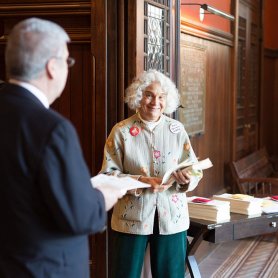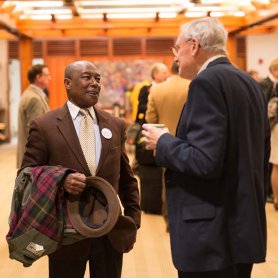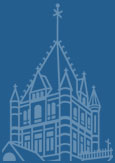Organs
While Trinity has one of the most successful and well attended weekly organ recital series in the country, hosting 35 recitalists per year from around the world, the primary purpose of the organ is to support worship. Indeed, of all the elements of Trinity’s inspiring building, the organ fills an essential and unique role of supporting and encouraging congregational singing and participation in our worship life. With 113 ranks totaling over 7,000 pipes, this is Boston’s second-largest organ and remains Boston’s most oft-heard pipe organ.
The Trinity Organ is, in fact, comprised of two organs:
The Chancel Organ (located at the front of the church, built in 1963, and cleaned and renewed in 2007), the primary role of which is accompanying the choir.
The Nave Organ (located at the rear of the church in the west gallery, built by the renowned Ernest M. Skinner in 1926, and tonally restored in 2019) serves as the main instrument to support congregational singing and solo organ repertoire. Together, these instruments are used in a variety of ways in worship and for recitals. Organists play both the Chancel and Nave organs from a single console located in the chancel.
Music has been integral to Trinity since the arrival of the first organ in 1744, and the Vestry’s decision in 1785 to set aside a pew for “such Persons as chuse to set in it who are capable of leading in the Singing.” For Trinity’s progressive new 1877 building in Copley Square, the organ could come only from Hilborne Roosevelt of New York, pioneer of electric-action and forward thinking. Installed in the church’s southeast corner, the Roosevelt organ reached five stories, from basement water motors to chancel ceiling Echo. But the location muffled the tone, not just of the organ but also the singers. Within a year, proposals surfaced to relocate all musical forces to the rear gallery.
Thus in 1880, the organ began a musical ricochet around the building. The Roosevelt was divided into the west gallery at either side of
La Farge’s “Christ in Majesty,” and updated in 1900 by James Cole. By 1902, however, Trinity acceded to the fashion for vested choirs of men and boys, hence a chancel organ by Hutchings-Votey, a modest three-manual with a console to play both organs. In 1924 the Skinner Company took over, first with a towering four-manual console and then, in 1926, a 54-voice nave organ. Louis Vierne, famed blind organist of Notre Dame Cathedral, singled it out for praise after a recital in April 1927. “Not a day passes,” he wrote to Skinner, “that I don’t dream about your magnificent instruments I played over there; their marvelous touch, their fine tone, their perfect and sensitive action haunt me. It seems as though I were dreaming when I think of Trinity Church, Boston...”
When the chancel was renovated again in 1938, Ernest Skinner & Son made tonal changes to both instruments, most notably recycling the 32’ Bombarde (some of the largest pipes) into Skinner & Son’s new organ for Washington National Cathedral. In 1954, both organs began tacking to an American Classic course with tonal alterations to make the instrument leaner, brighter, and more assertive. In 1956 came a compact three-manual Aeolian-Skinner console, and in 1963 a new chancel organ. Beginning in 1961, curator Jason McKown refashioned the sound of the nave organ, using many new Aeolian-Skinner pipes. By 1972 Faxon and McKown had achieved across 108 ranks a mild, even and elegant spread: the American Classic in its more suave guise, enriched with the best of Skinner’s remaining orchestral tones. In recital, Faxon’s registrational whimsy and rhythmic accuracy were an ideal match to its combined resources. Guest organists for Sunday evening choral offerings through the 1970s (Frederick MacArthur, Earl Eyrich, Thomas Murray) gloried in putting the organ through its louder paces, accompanying choral forces sometimes exceeding 100.
Ronald Arnatt’s brief tenure on the bench set in motion a new direction with the dramatic loudening of the nave Swell and Solo trumpets. Brian Jones’ time saw the addition of the copper trumpet beneath the west window in 1987. Initially voiced by Jack Steinkampf, it was subsequently mellowed by David Broome. The organ was mechanically rebuilt in phases by Foley- Baker between 1999 and 2007.
An ambitious project completed in 2019 sought to return the Nave Organ closer to its 1926 Skinner roots. Toward this end, Trinity began stockpiling vintage Skinner and early Aeolian-Skinner pipework in 2012. A new four-manual console by J. Zamberlan & Co. and Richard Houghten arrived in 2018, designed in conjunction with Jonathan Ambrosino. Mechanical work was handled Foley-Baker, Inc. while Jonathan Ambrosino managed the project and made tonal revisions with his collaborators Joe Sloane, Duane Prill, Ortloff Organ Co., and Christopher Broome.




